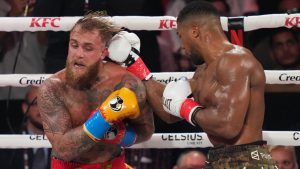UFC president Dana White announced late Wednesday the organization’s upcoming return to Alberta with a Nov. 2 Fight Night event set for Rogers Place in Edmonton.
A women’s flyweight bout between rising contender Erin Blanchfield and former two-time strawweight champion Rose Namajunas that carries title implications is featured in the main event, yet another element relevant to this card is the fact it will be the first UFC event to operate under a set of new rules.
The Association of Boxing Commissions and Combative Sports Mixed Martial Arts Committee voted in July to eliminate a rule prohibiting downward pointing elbow strikes, more commonly known as “12 to 6 elbows,” and updated the definition of what constitutes a “grounded” fighter.
Both new rules are set to come into effect Nov. 1, one day before the UFC hosts its third event in Edmonton. The organization previously held UFC 215: Nunes vs. Shevchenko 2 in 2019 and UFC 240: Holloway vs. Edgar in 2017 in the city.
The most notable incident of “12 to 6 elbows” impacting the result of a fight is when Jon Jones sustained his first and only official loss when he was disqualified for landing the illegal strike when he fought Matt Hamill in 2009.
The change in definition as to what constitutes a grounded opponent is likely to have a wide impact on the sport as fighters will be able to use certain kicking and kneeing techniques in positions where previously it would’ve been deemed an illegal strike.
Originally defined as: "Any part of the body, other than the sole of the feet touching the fighting area floor. To be grounded, the palm of one hand (a flat palm) must be down, and/or any other body part must be touching the fighting area floor. A single knee, arm, (not fingers) makes the fighter grounded without having to have any other body part in touch with the fighting area floor. At this time, kicks or knees to the head will not be allowed."
The rule is now as follows:
"A fighter shall be considered grounded and may not be legally kneed or kicked to the head when any part of their body other than their hands or feet is in contact with the canvas (ground)."
Three or four points of contact will become irrelevant if those points of contact are exclusively feet and hands. Fighters will only be considered grounded if a knee or elbow is contacting the canvas.
Fans can refer to a notable incident from the UFC 297 featherweight bout between Arnold Allen and Movsar Evloev from earlier this year as an example to draw from. Allen landed a knee to Evloev’s head when Evloev had two feet plus one hand touching the mat, which according to the soon-to-be-defunct rule rendered him a grounded fighter. Since the knee was illegal, the referee correctly halted the action and Evloev was granted time to recover, which impacted how the remainder of the fight unfolded.
Under the new rules, Evloev’s position – one that some fighters strategically use to avoid being kneed or kicked in the head – will not be considered grounded starting at UFC Edmonton.
While the rule changes won't guarantee athletes will frequently use "12 to 6" elbows or take advantage of the new grounded fighter definition, fans at Rogers Place will possibly be the first to witness fighters consider new strategies around the pair of rules set to come into effect.
Bouts currently scheduled for UFC Edmonton include:
-- Erin Blanchfield vs. Rose Namajunas
-- Derrick Lewis vs. Alexander Romanov
-- Chad Anheliger vs. Cody Gibson
-- Marc-André Barriault vs. Dustin Stoltzfus
-- Ariane Lipski vs. Jasmine Jasudavicius
-- Jamey-Lyn Horth vs. Ivana Petrovic






